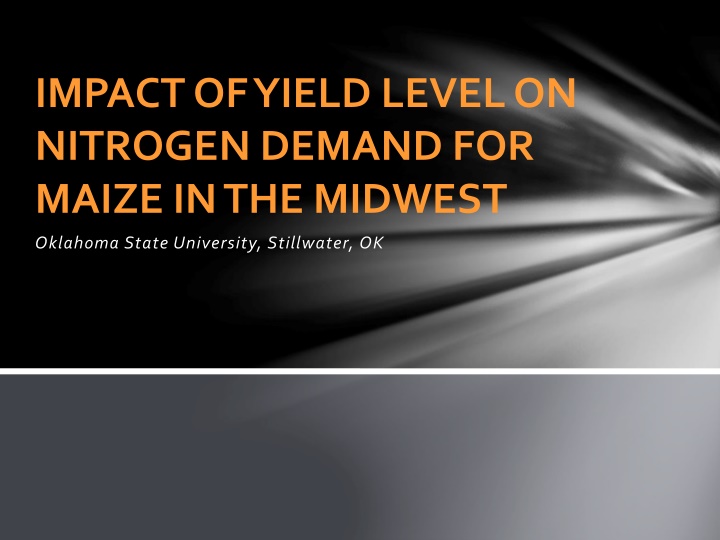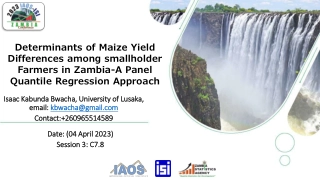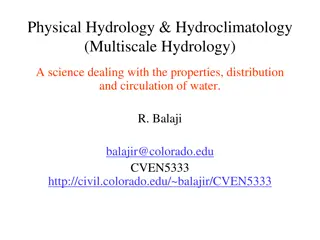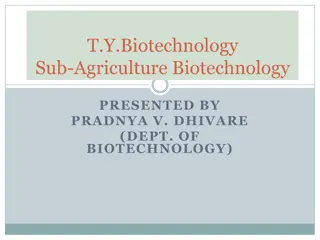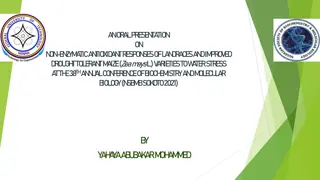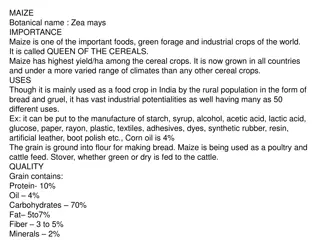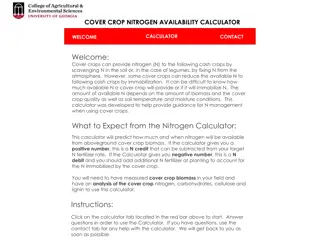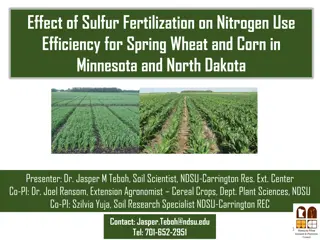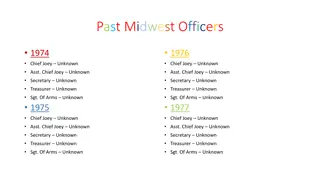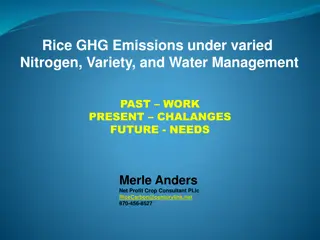Impact of Yield Level on Nitrogen Demand for Maize in the Midwest
Long-term trials at various locations in the Midwest explored the relationship between maize yield levels and nitrogen demand. Results from field experiments analyzed in the Central Great Plains emphasized the importance of optimal nitrogen rates for maximizing yield potential. Different sites and years showed varying responses, highlighting the complex interactions between grain yield and nitrogen rates. Understanding these dynamics is crucial for effective nitrogen rate recommendations in maize cultivation.
Download Presentation

Please find below an Image/Link to download the presentation.
The content on the website is provided AS IS for your information and personal use only. It may not be sold, licensed, or shared on other websites without obtaining consent from the author.If you encounter any issues during the download, it is possible that the publisher has removed the file from their server.
You are allowed to download the files provided on this website for personal or commercial use, subject to the condition that they are used lawfully. All files are the property of their respective owners.
The content on the website is provided AS IS for your information and personal use only. It may not be sold, licensed, or shared on other websites without obtaining consent from the author.
E N D
Presentation Transcript
IMPACT OF YIELD LEVEL ON NITROGEN DEMAND FOR MAIZE IN THE MIDWEST Oklahoma State University, Stillwater, OK
Long Term Trials Evaluated Year Initiated Years included (total years) Location Soil, management Crop 1Stillwater, OK, Magruder 2Arlington, WI 3Altus, OK, Exp. 406 Tillman-Hollister clay loam 3Altus, OK, Exp. 407 Tillman-Hollister clay loam Fine-silty, mixed, mesic, Pachic Haplustoll, 5Nashua, IA, NERF Kenyon loam 5Kanawha, IA, NIRF Webster silty clay loam Kirkland silt loam 1892 1958-2011 (53) OK WI OK OK winter wheat maize winter wheat winter wheat Plano silt loam 1958 1966 1966 1958-2007 (49) 1966-2011 (45) 1966-2011 (45) 4Shelton, NE 1991 1995-2005 (11) NE IA IA maize maize maize 1979 1954 1979-2010 (32) 1985-2010 (26) 261 2Bundy and Andraski (2004) 3Raun et al. (1998) 4Varvel et al. (2007) 5Mallarino and Ortiz-Torres (2006) Arnall, D.B., A.P. Mallarino, M.D. Ruark, G.E. Varvel, J.B. Solie, M.L. Stone, J. L. Mullock, R.K. Taylor, and W.R. Raun. 2013. Relationship between grain crop yield potential and nitrogen response. Agron. J. 105:1335 1344
Yield level and N Response, Wheat 70 Altus 406, 1966-2011 Check, 0N 60 High N Grain yield, bu/ac 50 40 30 20 10 0 1966 1970 1974 1978 1982 1986 1990 1994 1998 2002 2006 2010 Year
Yield level and N Response, Maize Arlington WI, 1984-2007 16 Check, 0N 14 High N 12 Grain yield, Mg ha-1 10 8 6 4 2 0 1984 1988 1992 1996 Year 2000 2004
Literature, N Rates Understanding that grain yield and N rate are not related is critical for N rate recommendations Analyzed a total of 170 site years of maize field experiments in the Central Great Plains. Optimum N rate = (N uptake max yield - N uptake check plot)/NUE
Maize Source Location Years Years High N Yield Range Optimum N rate Mg ha-1 Min Max Avg. Bundy et al. (2011) WI 20 1958-1983 4.3-8.8 46 213 119 Bundy et al. (2011) WI 23 1984-2007 5.7-14.1 143 334 230 Mallarino and Torres (2006) IA 32 1979-2010 5.1-12.5 75 316 195 Mallarino and Torres (2006) IA 26 1985-2010 5.3-12.8 124 326 215 Varvel et al. (2007) NE 11 1995-2005 10.4-13.6 67 280 191 Jokela et al.(1989) Carroll MN 3 1982-1984 7.1-9.1 5 120 77 Jokela et al.(1989) Webster MN 3 1982-1984 1.8-8.7 64 103 84 Fenster et al. (1976) Martin MN 7 1970-1976 7.12-10.65 21 116 60 Fenster et al. (1976) Waseca MN 7 1970-1976 4-9.6 55 227 140 Al Kaisi et al.(2003) CO 3 1998-2000 8.3-10.8 24 126 84 Ismail et al.(1994) KY 19 1970-1990 4.7-10.5 15 175 100 Rice et al.(1986) Total KY 16 170 1970-1985 5.7-9.2 average stdev 93 61 43 163 208 87 132 136 59 + sd 195 Avg. 136 - sd 77
Optimum N rates differed radically from one year to the next at all sites N rates temporally dependent and unpredictable within specific locations Fundamental theory has to right
LATITUDE The human mind, when stretched by a new idea, can never shrink to its original size Oliver Wendell Holmes
We cannot talk about agriculture without talking about the environment; we cannot talk about the environment with talking about agriculture; and we cannot talk about either without talking about the entire world. Dr. Bobby Stewart
By 2050 there will be 9.1 billion people. Increase of 30% Food production during the same period will have to increase 70% 95% of the increased population will be in the developing world
70 Magruder, 1958-2011 Check, 0N High N 60 50 Grain yield, Mg ha-1 40 30 20 10 0 1958 1962 1966 1970 1974 1978 1982 1986 1990 1994 1998 2002 2006 2010 Year
NIRF, Kanawha, IA, 1985-2010 14 Check, 0N High N 12 10 Grain yield, Mg ha-1 8 6 4 2 0 1985 1988 1991 1994 1997 2000 2003 2006 2009 Year
At the top of the food chain rankings, people in U.S. and Canada consume about 800 kg annually, mostly as meat, milk and eggs. At the bottom, India consumes about 200 kg consuming nearly all directly, leaving little for conversion to protein. The world average production of grain per person is about 350 kg per person compared to 285 in 1961. (Food and Agriculture Organization Statistics, Rome)
Bundy, Larry G., Todd W. Andraski, Matthew D. Ruark and Arthur E. Peterson. 2011. Long-term continuous corn and nitrogen fertilizer effects on productivity and soil properties. Agron. J. 103:1346-1351. Brezonik, P. L., Bierman Jr, V. J., Alexander, R., Anderson, J., Barko, J., Dortch, M., ... & Wiseman Jr, W. J. (1999). Effects of reducing nutrient loads to surface waters within the Mississippi River Basin and the Gulf of Mexico. National Oceanic and Atmospheric Administration National Ocean Service Coastal Ocean Program. Blevins, R. L., Cook, D., Phillips, S. H., & Phillips, R. E. (1971). Influence of no-tillage on soil moisture. Agronomy Journal, 63(4), 593-596. Bundy, L.G., and T.W. Andraski. 1995. Soil yield potential effects on performance of soil nitrate tests. J. Prod. Agric. 8:561 568 Cerrato, M.E., and A.M. Blackmer. 1990. Comparison of models for describing maize yield response to nitrogen fertilizer. Agron. J. 82:138 143. David, M. B., Gentry, L. E., Kovacic, D. A., & Smith, K. M. (1997). Nitrogen balance in and export from an agricultural watershed. J. Environ.Qual., 26(4), 1038-1048. Davis, D.M., P.H. Gowda, D. J. Mulla, and G.W. Randall. 2000. Modeling nitrate nitrogen leaching in response to nitrogen fertilizer rate and tile drain depth or spacing for southern Minnesota, USA. J. Env. Qual. 29:1568-1581. Derby, N. E., Steele, D. D., Terpstra, J., Knighton, R. E., & Casey, F. X. (2005). Interactions of nitrogen, weather, soil, and irrigation on maize yield. Agronomy journal, 97(5), 1342-1351. Fenster, W. E., C. J. Overdahl, Randall, G. W., & Schoper, R. P. (1978). Effect of Nitrogen Fertilizer on Maize Yield and Soil Nitrates (Vol. 153). Agricultural Experiment Station, University of Minnesota. Ismail, I., Blevins, R. L., & Frye, W. W. (1994). Long-term no-tillage effects on soil properties and continuous maize yields. Soil Science Society of America Journal, 58(1), 193-198 Jaynes, D. B., Colvin, T. S., Karlen, D. L., Cambardella, C. A., & Meek, D. W. (2001). Nitrate loss in subsurface drainage as affected by nitrogen fertilizer rate. J. Environ.Qual. 30(4), 1305-1314. Jokela, W. E., & Randall, G. W. (1989). Maize yield and residual soil nitrate as affected by time and rate of nitrogen application. Agronomy journal, 81(5), 720-726. Lory, J.A., and P.C. Scharf. 2003. Yield goal versus delta yield for predicting fertilizer nitrogen need in maize. Agron. J. 95:994-999. Mallarino, A.P., and E. Ortiz-Torres. 2006. A long-term look at crop rotation effects on maize yield and response to N fertilization. In: The Integrated Crop Management Conference Proceedings, Ames, IA. 29 30 Nov. 2006. Iowa State Univ. Ext., Ames. p. 209 213. Malzer, G.L., P.J. Copeland, J.G. Davis, J.A. Lamb, P.C. Robert, and T.W. Bruulsema. 1996. Spatial variability of profitability in site- specific N management. p. 967 975. In P.C. Robert et al. (ed.) Precision agriculture. Proc. Int. Conf., 3rd, Minneapolis, MN. 23 26 June 1996. ASA, CSSA, and SSSA, Madison, WI Mamo, M., Malzer, G. L., Mulla, D. J., Huggins, D. R., & Strock, J. (2003). Spatial and temporal variation in economically optimum nitrogen rate for maize. Agron. J. 95(4), 958-964. Onken, A.B., R.L. Matheson, and D.M. Nesmith. 1985. Fertilizer nitrogen and residual nitrate-nitrogen effects on irrigated maizeyield. Soil Sci. Soc. Am. J. 49:134 139. Randall, Gyles W., Jeffrey A. Vetsch, and Jerald R. Huffman. 2003. Maize production on a subsurface-drained mollisol as affected by time of nitrogen application and nitrapyrin. Agron. J. 95:1213-1219. Raun, W. R., J. B. Solie & Stone, M. L. (2011). Independence of yield potential and crop nitrogen response. Precision Agriculture, 12(4), 508-518 Scharf, P. C., Kitchen, N. R., Sudduth, K. A., Davis, J. G., Hubbard, V. C., & Lory, J. A. (2005).Field-scale variability in optimal nitrogen fertilizer rate for maize. Agron. J. 97(2), 452-461. Schlegel, A.J., and J.L. Havlin. 1995. Maize response to long-termnitrogen and phosphorus fertilization. J. Prod. Agric. 8:181 185. Varvel, G.E., W.W. Wilhelm, J.F. Shanahan, and J.S. Schepers. 2007. An algorithm for maize nitrogen recommendations using a chlorophyll meter based sufficiency index. Agron. J. 99:701-706. Vetsch, Jeffrey A., and Gyles W. Randall. 2004. Maize production as affected by nitrogen application timing and tillage. Agron. J. 96:502-509.
Grain production is vital because worldwide people get 48% of their calories from eating grain directly. As incomes rise, the percent drops dramatically as diets change to include more meat, milk, eggs and other foods that require more grain to produce. About 48% of grains are eaten directly, 35% fed to animals, and 17% for ethanol and other fuels. Worldwatch Institute, August 12, 2011 worldwatch.org
